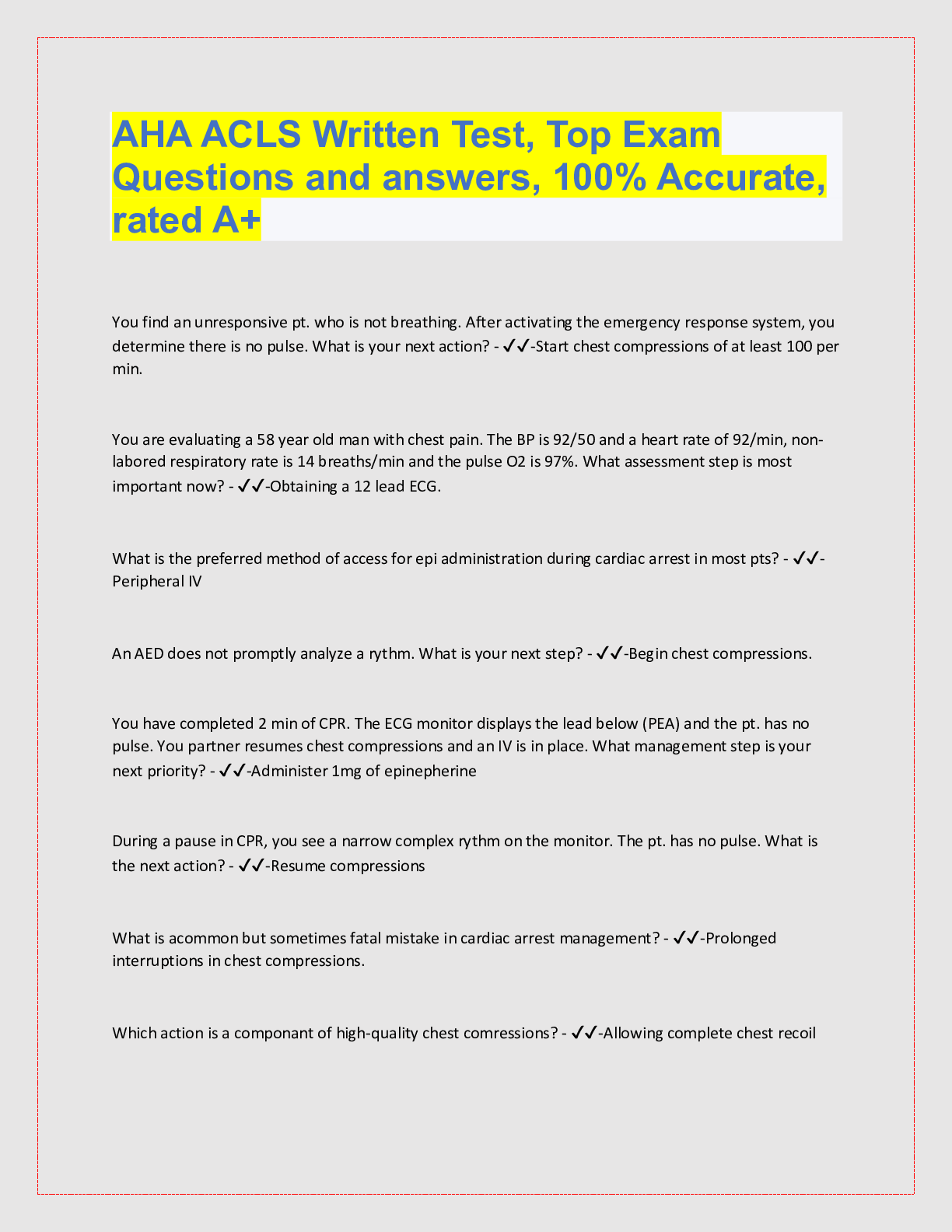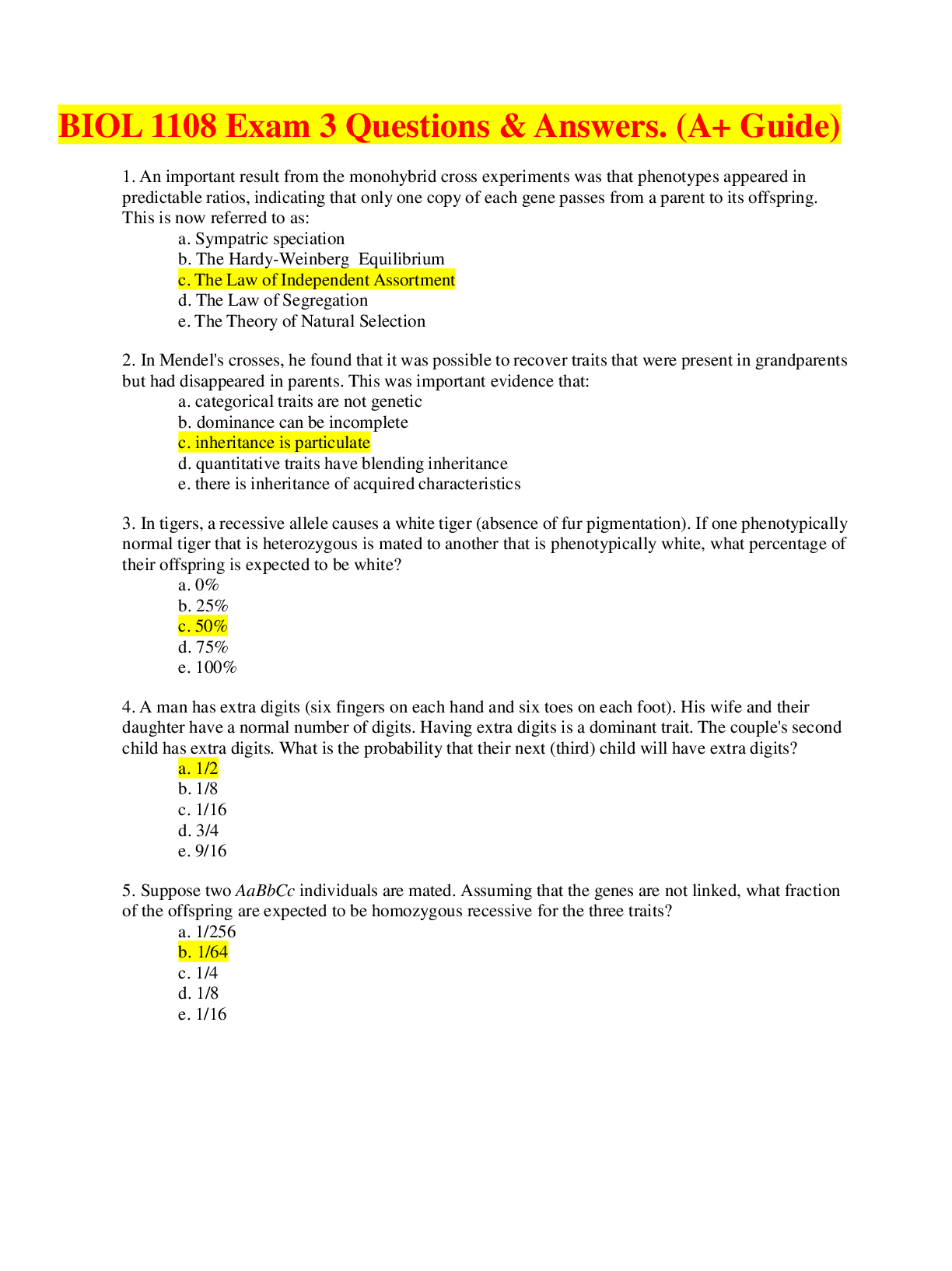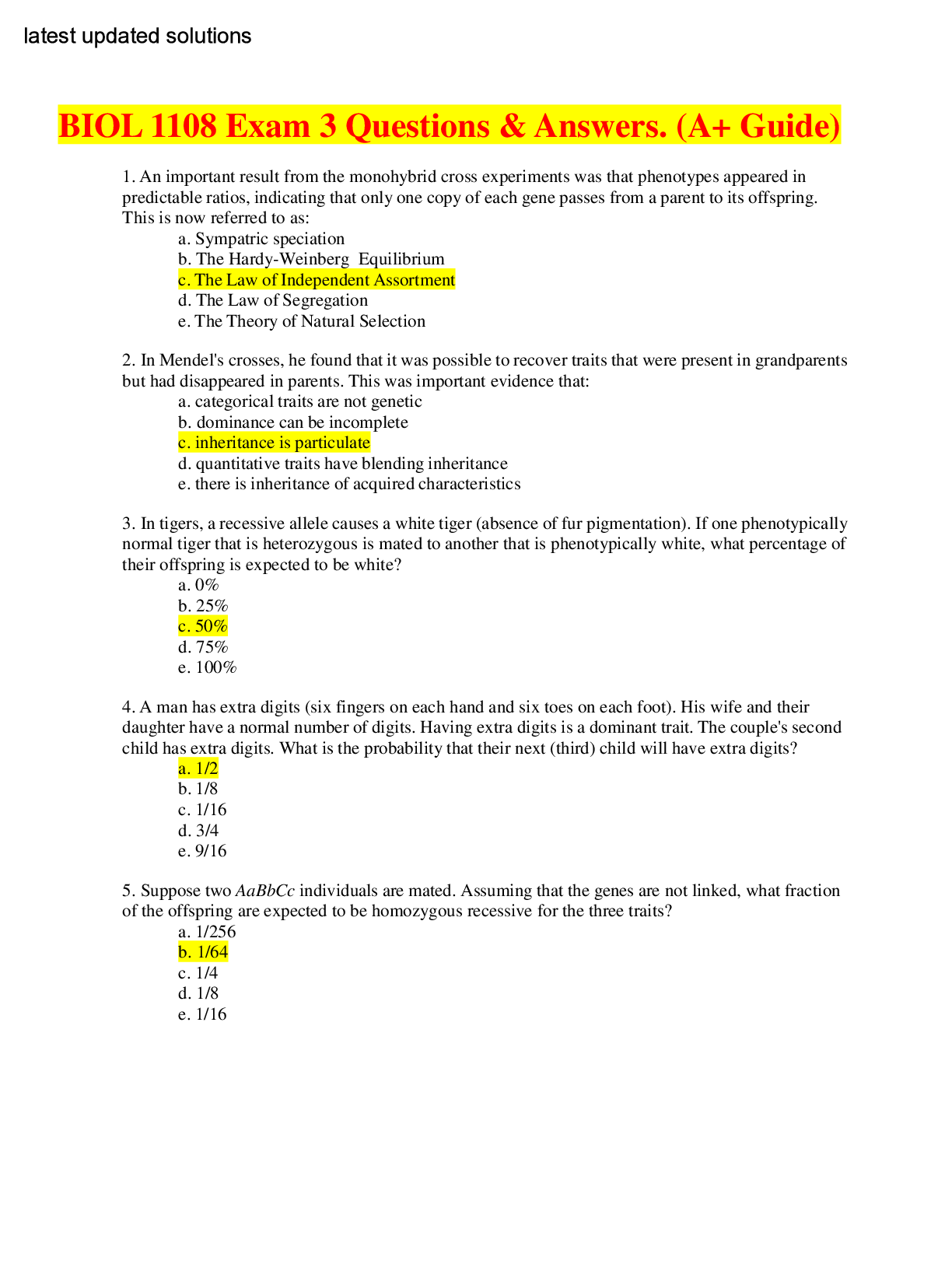Biology > EXAM > Biology 1108 Exam 3/ University Of Connecticut BIOL 1108 Exam 3 (answered) Spring 2022/2023 (All)
Biology 1108 Exam 3/ University Of Connecticut BIOL 1108 Exam 3 (answered) Spring 2022/2023
Document Content and Description Below
Biology 1108 Exam 3 1. An important result from the monohybrid cross experiments was that phenotypes appeared in predictable ratios, indicating that only one copy of each gene passes from a parent t... o its offspring. This is now referred to as: a. Sympatric speciation b. The Hardy-Weinberg Equilibrium c. The Law of Independent Assortment d. The Law of Segregation e. The Theory of Natural Selection 2. In Mendel's crosses, he found that it was possible to recover traits that were present in grandparents but had disappeared in parents. This was important evidence that: a. categorical traits are not genetic b. dominance can be incomplete c. inheritance is particulate d. quantitative traits have blending inheritance e. there is inheritance of acquired characteristics 3. In tigers, a recessive allele causes a white tiger (absence of fur pigmentation). If one phenotypically normal tiger that is heterozygous is mated to another that is phenotypically white, what percentage of their offspring is expected to be white? a. 0% b. 25% c. 50% d. 75% e. 100% 4. A man has extra digits (six fingers on each hand and six toes on each foot). His wife and their daughter have a normal number of digits. Having extra digits is a dominant trait. The couple's second child has extra digits. What is the probability that their next (third) child will have extra digits? a. 1/2 b. 1/8 c. 1/16 d. 3/4 e. 9/16 5. Suppose two AaBbCc individuals are mated. Assuming that the genes are not linked, what fraction of the offspring are expected to be homozygous recessive for the three traits? a. 1/256 b. 1/64 c. 1/4 d. 1/8 e. 1/16 6. In the F2 generation of the monohybrid cross, it is possible to get 3 phenotypes. What is this evidence for and what is the ratio of the phenotypes? a. Complete dominance, 1:1:1 ratio b. Genetic drift, 1:1:1 ratio c. Incomplete dominance, 1:2:1 ratio d. Blending inheritance, 1:2:1 ratio e. Gene flow, 1:2:1 ratio 7. Mendel performed a dihybrid cross and got recombinant as well as P generation phenotypes in the F2 generation. This was evidence for: a. Dependent assortment b. Independent assortment c. Mutation d. Natural selection e. Plagiarism 8. Snapdragons are flowers that come in a variety of colors, including red, pink, and white. Whenever the dominant allele of either (or both) gene A or gene B is present, red color is produced. A cross of AaBb × AaBb can be expected to yield how many red offspring out of 16? Assume the genes are not linked. a. 1 b. 4 c. 12 d. 15 e. 16 9. A heterozygous, but phenotypically wild-type fruit fly (gray body color and normal wings) was mated to a black fly with vestigial wings. The offspring had the following phenotypic distribution: wild type, 720; black-vestigial, 780; black-normal, 280; gray-vestigial, 220. What conclusion do you draw from these results? a. Epistasis has modified a 9:3:3:1 ratio. b. The black and vestigial loci are allelic. c. The black and vestigial loci are linked. d. The black and vestigial loci assort independently from each other. 10. A strain of mice comes in brown, black and white coat colors. White mice crossed with white mice always make white mice, but any other cross can make litters with all three colors. Further genetic work reveals that two loci are involved. This is a case of: a. blending inheritance b. codominance c. epistasis d. incomplete dominance e. mutation 11. Assume that you know there are two alleles at a locus; one is dominant and the other recessive. If you know genotype frequencies in a population, in order to predict allele frequencies that will determine the makeup of the next generation you must also assume a. A small population b. Hardy-Weinberg equilibrium c. Intense natural selection d. Rapid mutation e. None of the above 12. The frequency of a recessive phenotype in a population in Hardy-Weinberg equilibrium is 0.16. What is the frequency of the dominant allele? a. 0.20 b. 0.36 c. 0.40 d. 0.60 e. 0.80 13. Suppose 64% of a remote mountain village can taste phenylthiocarbamide (PTC) and must therefore have at least one copy of the dominant PTC taster allele. If this population conforms to Hardy-Weinberg expectations for this gene, what percentage of the population must be heterozygous for this trait? a. 16% b. 32% c. 40% d. 48% e. 60% 14. A large population has few alleles at every locus. You suspect that this is a case of: a. Assortative mating b. Bottleneck c. Gene flow d. Mutation e. Random mating 15. At a color locus with two codominant alleles, you have genotype frequencies of 0.6, 0.3 and 0.1. The population is in Hardy-Weinberg Equilibrium. What is the frequency of the more common allele? a. 0.6 + ½*0.3 b. 2*0.6 + 0.3 c. Square root of 0.6 d. a. and c. e. none of the above 16. Who independently reached essentially the same ideas regarding evolution by natural selection as Darwin? a. Hutton b. Lamarck c. Lyell d. Mendel e. Wallace 17. Lamarck's explanation for evolution included the idea (put into more modern terms) that a. inheritance of genetic variability is particulate b. more offspring are produced by homozygous parents c. offspring retain changes that occur to the phenotypes of parents d. offspring are more well-mannered if the parents are French e. only small changes have occurred since the creation described in the Bible 18. Which of the following best describes the role of natural selection in evolutionary theory? a. changes in gene pools due to natural selection are insignificant b. microevolution has replaced natural selection as an organizing concept c. natural selection has been discarded as an important concept d. natural selection is the only source of evolutionary change e. natural selection produces adaptations that are an important result of evolutionary change 19. Three-spined stickleback fish (Gasterosteus aculeatus) show substantial heritable variation in gillraker length. Fish caught in open water tend to have longer gill rakers than do those caught in shallower water. Longer gill rakers appear to function better for capturing open-water prey, while shorter gill rakers function better for capturing shallow-water prey. Which of the following types of selection is most likely to be found in a large lake (open water in middle and shallow water around the sides) with a high density of these fish? a. directional selection b. disruptive selection c. no selection d. sexual selection e. stabilizing selection 20. Which of the following did Darwin NOT understand about evolutionary change? a. that competition exists in populations b. that organisms became extinct c. that populations overproduce offspring d. that variation is common in populations e. the source of genetic variation 21. House finches were found only in western North America until 1939, when a few individuals were released in New York City. These individuals established a breeding population and gradually expanded their range. The western population also expanded its range somewhat eastward, and the two populations have recently come in contact. If the two forms were unable to interbreed when their expanding ranges meet, what would this situation definitely illustrate? a. allopatric speciation b. autopolyploidy c. hybrid breakdown d. prezygotic gametic isolation e. sympatric speciation 22. If a plant species with 2n = 14 forms an allopolyploid with a plant species with 2n = 18, what would be the likely diploid (2n) number of the allopolyploid? a. 16 b. 28 c. 32 d. 36 23. Darwin's finch species on the Galapagos rarely hybridize. The offspring of hybrid mating survive well and are reproductive. Hybrid females choose to mate with males that sing the same song as the females' fathers. These observations are evidence for a. cryptic speciation b. postzygotic isolation by hybrid breakdown c. prezygotic behavioral isolation d. prezygotic gametic isolation e. sympatric speciation 24. Which of the following situations can the biological species concept not deal with? a. allopatric species b. asexual taxa c. cryptic species d. sexually dichromatic taxa e. sympatric species 25. The common edible frog of Europe is a hybrid between two species, Rana lessonae and Rana ridibunda. The hybrids were first described in 1758 and have a wide distribution, from France across central Europe to Russia. Both male and female hybrids exist, but when they mate among themselves, they are rarely successful in producing offspring. What can you infer from this information? a. Postzygotic isolation exists between the two frog species. b. The two parental species must have originated sympatrically. c. Prezygotic isolation exists between the two frog species. d. The hybrids form a separate species under the biological species concept. e. These two species are likely in the process of fusing back into one species. 26. One fine day in November you capture 200 turkeys and mark them. Later that week you come back and capture 500 turkeys, 50 of which are marked. Your best estimate of the population size of turkeys is: a. 50*20/500 b. 50*200/50 c. 500 d. 200*500/50 e. none of the above 27. The age structure depicted here is most likely to come about as the result of: a. a declining birth rate b. a high birth rate c. a high carrying capacity d. a low r max e. decreasing population size 28. In this distribution pattern, the distance between nearest neighbors varies a great deal with direction. The best explanation for this pattern is that a. competition for resources is intense b. resources are patchily distributed c. the density of the population is low d. the population is spreading out and increasing its range e. there is an absence of strong attraction or repulsion among individuals 29. Which of the survivorship curves best applies when mortality rate is constant with age? a. A b. B c. C d. None of these applies e. Not enough information has been given to decide 30. Which of the following statements about population vital rates must be true? a. Fecundity is highest at the age of maturity and then decreases b. Mortality rate goes up sharply near the maximum lifespan c. Mortality rate is highest in the youngest age classes d. Survivorship always decreases with age e. Survivorship can be near zero at birth and then increase 31. In which population plotted here are the PER CAPITA birth and death rates most different? a. A b. B c. C d. D e. It cannot be determined from the information given 32. In the logistic equation for population growth, at low population sizes population growth is a. Negative b. Relative rapid, because at larger N the value of r max is lower c. Relatively rapid, because birth rates are high and death rates are low d. Relatively slow, because there are few individuals breeding e. Relatively slow, because there is intense competition for limited resources 33. In the logistic equation for population growth, the growth rate of the population is greatest when a. Population size is above carrying capacity b. Population size is close to 0 c. Population size is close to carrying capacity d. Population size is infinite; the population is growing at an accelerating rate e. Population size is roughly halfway to carrying capacity 34. Carrying capacity, K, is a. A function of reproductive rates and age at first reproduction b. determined by the amount of resources in the environment c. determined by mortality rates d. A and B e. A and C 35. As used in the logistic equation for population growth, the intrinsic rate of natural increase, r max, will be most affected by a. Age at maturation b. Availability of limiting resources c. Competition d. Population size e. Weather 36. Which of the following statements is TRUE about the causes of extinction? a. A cause has never been identified for any species of animal or plant b. Exploitation for food has been the most important factor for all major groups of animals and plants c. Habitat loss has been a major factor in some large groups, such as fishes d. The only thing that has ever caused a species extinction is an asteroid 37. Extinction rates in the present day a. Cannot be estimated b. Are at least 1000 times the natural, background rate c. Are impossible to reduce d. Are not influenced by humans e. Are about 1/5 of the natural, background rate 38. The IUCN maintains data on a. Areas of deforestation b. Diseases c. Endangered and threatened species d. Invasive species e. Reserves and parks 39. Which of the following is most likely to accelerate the process known as the extinction vortex? a. gene flow b. genetic drift c. invasive species d. mutation e. natural selection 40. A species is considered invasive when it a. Causes some sort of economic harm b. Is not native to the location c. Is very different from other species native to the area d. a. and b. e. a., b. and c. Powered by TCPDF (www.tcpdf.org) [Show More]
Last updated: 2 years ago
Preview 1 out of 8 pages

Buy this document to get the full access instantly
Instant Download Access after purchase
Buy NowInstant download
We Accept:

Reviews( 0 )
$13.00
Can't find what you want? Try our AI powered Search
Document information
Connected school, study & course
About the document
Uploaded On
Feb 25, 2022
Number of pages
8
Written in
Additional information
This document has been written for:
Uploaded
Feb 25, 2022
Downloads
0
Views
211





.png)











